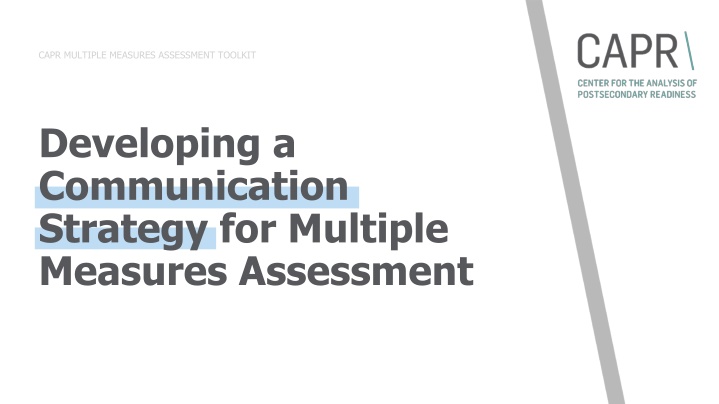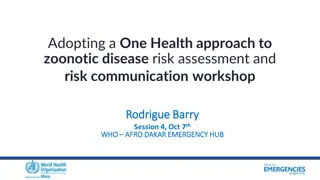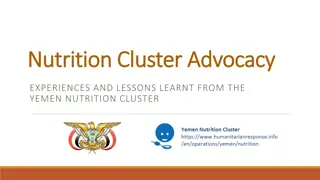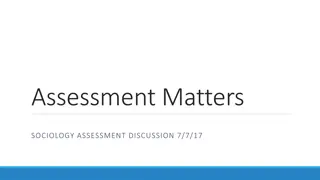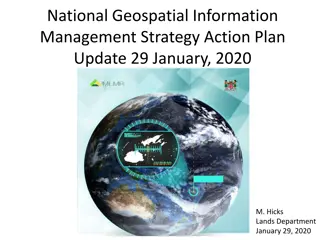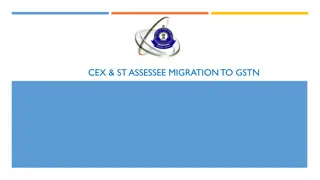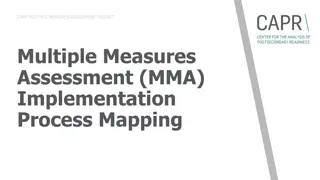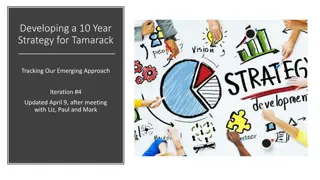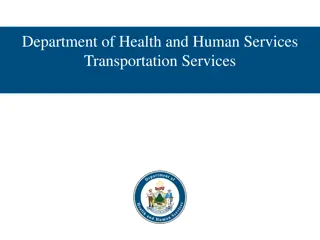Developing a Communication Strategy for Multiple Measures Assessment
"The importance of developing a communication strategy for Multiple Measures Assessment (MMA) to ensure consistent messaging, facilitate transitions, and raise awareness among stakeholders. Learn how to effectively inform and engage internal and external stakeholders at key points throughout the assessment process. Discover communication outlines, strategies, and key points for successful implementation."
Download Presentation

Please find below an Image/Link to download the presentation.
The content on the website is provided AS IS for your information and personal use only. It may not be sold, licensed, or shared on other websites without obtaining consent from the author.If you encounter any issues during the download, it is possible that the publisher has removed the file from their server.
You are allowed to download the files provided on this website for personal or commercial use, subject to the condition that they are used lawfully. All files are the property of their respective owners.
The content on the website is provided AS IS for your information and personal use only. It may not be sold, licensed, or shared on other websites without obtaining consent from the author.
E N D
Presentation Transcript
CAPR MULTIPLE MEASURES ASSESSMENT TOOLKIT Developing a Communication Strategy for Multiple Measures Assessment
At a glance The Why, Who, When, How, and What of an MMA communication strategy What does each role/department need to know and to communicate? Developing your communication strategy Typically the implementation team designs the communication plan and oversees/executes parts of the plan Internal stakeholders (administrators, faculty, advisors, testing professionals, and other staff) can also help implement the plan
Why develop an MMA communication strategy? Raise awareness and understanding Ensure consistent messaging Facilitate a smoother transition Learn from each other Other?
MMA communication outline External stakeholders o High school staff and other external partners who work with prospective students Internal stakeholders o Administrators o Faculty o Staff: Advisors, registrars, testing professionals, IT professionals, other staff o Students WHO to inform WHEN to inform HOW to inform WHAT are key points
MMA communication outline WHO to inform At pivotal points, including: o After decision to adopt MMA o While designing placement rules o After placement rules have been developed o While planning process changes for faculty and staff o After solidifying new placement procedures o As part of monitoring and evaluation WHEN to inform HOW to inform WHAT are key points
MMA communication outline WHO to inform o Workshops o Professional development o Department or campus-wide meetings o Special trainings for departments with a large role in placement o Reference materials (websites, handouts) WHEN to inform HOW to inform WHAT are key points
MMA communication outline Upcoming changes to course placement: o Students will be placed into courses using multiple measures o Measures used to determine placement o Changes to roles and day-to-day responsibilities Why the transition?: o Legislative mandate (if applicable) o Nationwide research suggests that using multiple measures increases the number of students who have access to and succeed in college-level courses. o H.S. GPA has been shown to be a particularly good predictor of student performance it s an aggregate measure of student performance and behaviors over multiple years Request feedback: o During design and development phases WHO to inform WHEN to inform HOW to inform WHAT are key points
What are the key points? Key points and discussion topics will vary by stakeholder group. Advisors/ Counselors Admissions Registrar/IT/IR Faculty Testing For each group, Share general information about the transition to MMA (the what and why) using the Making the Case for MMA slides from the toolkit Discuss expected changes to day-to-day activities or that group s role in the new student process
What do stakeholders need to know? Consider the following for each stakeholder group: What will they need to know for their role? What does each department need to know? What does each group need to communicate with others? Will they need to share information with students? If so, what are key points they ll need to communicate? Will they need to share information with other staff? If so, what are the key points they ll need to communicate? Best practice: Allow each stakeholder group to reflect on these questions. Work together to fill any knowledge gaps and add this to your communication strategy. See FAQs for Faculty and Staff for answers to common questions about MMA.
Reflect and revise Consider the following throughout the implementation process: What has already been done to communicate about MMA? Does the communication plan need to be changed or augmented? What part of the plan needs to be executed next? Are there groups that still need to be informed or trained about MMA? How will this be accomplished Who will lead the effort? Update the communication strategy as necessary.
Thank you! The Center for the Analysis of Postsecondary Readiness (CAPR) is funded through a grant (R305C140007) from the Institute of Education Sciences, U.S. Department of Education.
